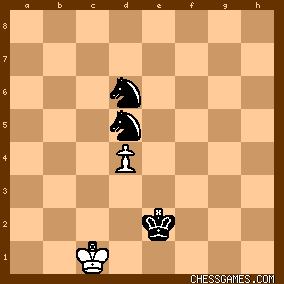| Aug-03-03 | | crafty: 96. ♔a1 ♔c2 97. ♔a2 ♘c3+ 98. ♔a1 ♘d2 99. d6 ♘b3# (eval -Mat04; depth 11 ply; 10M nodes) |
|
Aug-04-03
 | | Honza Cervenka: Or 96.d6 Nc3+ 97.Ka1 Kc2 98.d7 Na5 99.d8=Q Nb3# |
|
| Mar-28-06 | | IT4LICO: one of the most difficoult forced mate to find. Black won just because white as still a pawn and there are no risks of stallmate... |
|
| Mar-28-06 | | Jim Bartle: Very picturesque position after move 40, with the four knights lined up diagonally. Good game afterward, too. Does the 50-move rule apply in situations like this? |
|
| Mar-28-06 | | Runemaster: <Jim> Yes, the 50 move rule applies. From moves 60-87 in this game, there was no capture or pawn move, but that's only 27 moves, so not really close. The 4-knight ending was nice - I've only ever had two of those in all the games I've played, so I assume they're rare. How many times have other kibitzers had that type of ending? |
|
| Mar-28-06 | | Jim Bartle: How many moves (minimum) does it take to mate with 2 knights vs. one pawn? I assume if you don't do it perfectly you'll overstep the 50 moves. |
|
| Mar-29-06 | | pawn to QB4: Minimum number of moves varies on position; the example in Keres' "Practical Chess Endings" (White Kd7, Nd2+d3; black Kb6, d4) takes 30 moves, suggesting you might have room for the odd minor goof. The important thing is that the black pawn must be blockaded before it reaches a3, b5, c4, d3 etc (a6 etc for White) - an oddly shaped line discovered by the study composer Troitsky. I suppose in "Practical" Keres includes endings likely to come up for the average player once a century! Well played Gurevich to cope so smoothly when it happened. Runemaster, I've never had a 4 knight ending in 35 years play, so at that rate might get away without messing up 2N v P. |
|
| Mar-29-06 | | pawn to QB4: Smyslov vs Lilienthal, 1941 is the example that most interests me, with possible wins based on the king being already in an unfavourable corner and made to stay there. Thanks to Fenfiend whose collection includes 19 examples, some others of which show masters failing to cope. |
|
| Dec-14-07 | | MoonlitKnight: A comment to a recent article at chessbase.com clarifies: <Sotiris Logothetis, Athens, GreeceI am an International Arbiter. All extenstions to the 50-move rule were abolished at the Manila Congress in 1992, effective from July 1st, 1993. The first event with 50 moves for all cases was the Biel Interzonal back then, where a case arose with M. Gurevich, who had a winning 2Ns vs P endgame that required more than 50 moves to be won, against Rogers I think. In the end he won much earlier. According to the rules, the 50-move rule applies in ALL positions. Thus, indeed, several such endgames – that require much more than 50 moves to be won – are in practical terms drawn, provied of course the defender plays well enough.> |
|
| Aug-28-08 | | 4tmac: 
click for larger view After 87. Kc1 ..... Black had played well & could in fact have done it in 50 moves at this point (after move 59 black could win in only 43 moves!) 87. ... Nc4! 88. Kc2 Ke3! 89. Kb3 Kd3!. After 87. ... Nb4? it is true white moved the pawn "resetting" the 50 moves but now it would be very close since the white King gets away with 92. Ka4!. But after 92. Kb2?! the game came to a merciful end. |
|
| Nov-11-14 | | Howard: Geez, I didn't know that this game involved that particular endgame until looking at it just a few moments ago. |
|
| Jul-23-19 | | doash: So, how does Black win after 92. Ka4? Ans if the King escapes here, why can't he keep escaping? |
|





